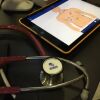Ultrasound is imaging and interpretation of high frequency sound waves. It has been around for years, but little understood by EMS providers.
New devices and applications were explored by military medicine during our recent conflicts with some outstanding results. That led to domestic proponents and an increasing number of EMS systems evaluating it. The clinical benefits have been both significant and varied.
It can quickly and definitively identify abdominal bleeding and pneumothorax. It can also provide real time imaging of the heart and great vessels. It can even find tough veins for an IV. Ultrasound is the first practical technology to offer EMS any kind of imaging capability.
I think that has been its biggest challenge. EMS has long relied on signs and symptoms, things you can see, feel, and hear from outside the body.
Not having much frame of reference on imaging has made considering ultrasound a challenge for me. That doesn’t make it less potentially important or viable.
This is a well-defined skillset with accepted standards and readily available curriculum. This is something EMS can learn to do, if they have the time, money, and commitment to do it.
In many areas that really won’t be an option. But in some, it certainly could and perhaps should be. It would require no small expense and dedicated training time.
The benefits of that investment, however, could be huge. Ultrasound devices can spot as little as 200cc of blood in the abdomen. Imagine knowing your patient would soon go into shock before their BP crashes. Imagine being able to see exactly where that ET tube tip is located. Imagine being able to look inside your patient and see what’s wrong.
Today we have three promising ultrasound devices with EMS potential. I’m not sure it is entirely fair to compare them directly. Each was designed with a different emphasis in mind. Some have many modes of operation, while others target a more limited set of specific functions. Here are the current contenders;
Sonosite NanoMaxx
The NanoMax exceeds military specifications for ruggedness and reliability. It is ready to scan within seconds. It carries an impressive five-year warranty and even has a built-in kick stand on the back. It is probably one of the more versatile portable ultrasound devices.
GE Vscan
The Vscan is a pocket size visualization tool, providing black and white anatomic and color-coded blood flow images. It can easily be integrated into the physical examination. The Vscan is optimized for quick inspection of the heart and abdominal organs.
Siemens Acuson P10
The ACUSON P10 was designed with the FAST (Focused Assessment with Sonography in Trauma) exam in mind. FAST exams are designed to give the clinician the ability to rapidly identify blood in the peritoneal, plural or pericardial spaces.
I have a lot to discover about ultrasound and its place in EMS. At EMS Today in Baltimore this week, I will take a close look at the latest devices. I’ll let you know right here on EMS1 what I learn.



